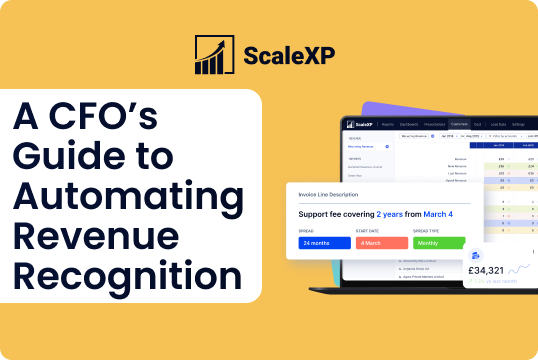Types of Revenue Recognition: A CFO’s Guide to Automating Revenue Recognition
Revenue recognition is one of the most complex, time-consuming, and high-stakes areas of accounting.
For CFOs across every industry — from software and professional services to manufacturing, telecom, and media — it’s a constant challenge: recognising revenue accurately while staying compliant with ASC 606 or IFRS 15.
Every business model introduces a new variable: upfront payments, usage billing, milestone-based projects, or long-term contracts. Each requires a different recognition approach — and every change, renewal, or cancellation creates another manual adjustment.
Most finance teams still manage this with spreadsheets. It works when you’re small, but it quickly turns into chaos: formulas break, timing errors creep in, and audits become stressful.
The opportunity? Turn compliance complexity into clarity with automation. Modern systems like ScaleXP apply the rules of revenue recognition automatically — so CFOs gain speed, accuracy, and confidence in every number.
Why Revenue Recognition Matters
Revenue recognition is more than compliance — it’s the foundation of trustworthy financial reporting.
Accurate timing determines how your organisation reflects growth, cash flow, and performance to investors and boards.
When recognition rules are applied inconsistently or managed manually, CFOs face serious risks:
- Distorted revenue trends that misinform decisions
- Incorrect numbers provided to the CEO, the board or investors resulting in a complete loss of credibility
- Audit and compliance exposure
- Slow, error-prone month-end closes with multiple checks to prevent embarrassing mistakes
Modern finance teams must align recognition with actual service delivery — not just billing — to maintain integrity, accuracy, and speed.
Common Revenue Recognition Methods
Every business model falls into a few key categories. Understanding them helps CFOs design consistent, scalable, and compliant recognition policies.
- Point-in-Time Recognition: Revenue is recognised when control of goods or services transfers to the customer — typically at delivery, shipment, or activation. Example: A software licence activated, equipment shipped, or setup completed.
- Over-Time — Annual, Quarterly, 2 months, 2 years: Annual, quarterly, or monthly contracts – with revenue spread across their service periods.
- Milestone-Based — Synced to Your Delivery Systems: ScaleXP makes it easy to import data from your project management tools and CRMs through a live and flexible Google Sheets integration. As milestones are marked complete, the platform automatically recognises the corresponding portion of revenue — maintaining a full, auditable trail from project data to journal entry.
- Usage-Based (Consumption) Recognition: Revenue follows customer activity — per transaction, API call, seat, or hour used. Example: Telecom, utilities, or metered cloud platforms.
- Percentage-of-Completion Recognition: For long-term projects, revenue is recognised progressively based on input (costs incurred or hours worked) or output (deliverables completed). Example: Construction, engineering, or manufacturing contracts.
- Variable Consideration: When revenue depends on performance outcomes — such as rebates, bonuses, or contingent milestones — ScaleXP updates recognition automatically as soon as results are confirmed. In most cases, these can be extracted automatically from your accounting system.
- Multi-Tiered (Hybrid) Recognition — Combining Upfront and Deferred Elements: Some contracts include both immediate and ongoing performance — for example, a hardware sale with bundled software or service subscriptions. Part of the revenue is recognised upfront, while the remainder is spread over the service period.
Why It Matters
Most modern businesses use several of these methods at once — a subscription model might include upfront setup fees, recurring services, and usage-based charges.
Managing that manually in Excel or Google Sheets is error-prone, time-intensive, and almost impossible to audit at scale.
That’s why automation has become essential. Once your recognition rules are defined, a system like ScaleXP applies them automatically — across every contract, entity, and currency — ensuring accuracy, compliance, and complete audit readiness.
Why Automation Is Important
Most modern businesses apply several of these methods simultaneously — a single contract might include setup fees, recurring services, and usage-based components.
Managing that manually is slow, error-prone, and difficult to audit.
Automation solves these challenges by:
- Applying consistent recognition logic to every transaction
- Recalculating automatically when contracts renew, cancel, or change
- Maintaining audit-ready records without manual spreadsheets
- Connecting data across billing, project, and accounting systems in real time
With automation, CFOs gain the twin benefits of speed and accuracy — freeing their teams to focus on analysis and strategy, not data maintenance.
How ScaleXP Automates Each of the Seven Types
ScaleXP connects seamlessly with your accounting, billing, and CRM platforms — including Xero, QuickBooks, Stripe, Chargebee, HubSpot, and Salesforce — and applies ASC 606 / IFRS 15 logic automatically.
Every revenue stream follows its correct rule in real time, updating the moment billing or usage data changes.
1. Point-in-Time — Instant, Accurate, Audit-Ready
When goods are delivered or services activated, ScaleXP posts recognition entries automatically.
No manual deferrals, no timing errors — just compliant, real-time accuracy.
2. Over-Time — Dynamic, Effortless Maintenance
ScaleXP’s custom AI models extract service periods directly from your invoices and contracts, ensuring every schedule is based on accurate, real-time data.
At month-end, finance teams simply review the suggested dates — a quick accuracy check that ensures 100% confidence.
Revenue is then allocated automatically, in just a few clicks.
Renewals, cancellations, and currency changes trigger instant recalculation — no spreadsheet rebuilds or manual edits.
3. Milestone-Based — Integrated and Traceable
Whether using Salesforce, HubSpot, or project tools like Monday.com, ScaleXP imports milestones via live Google Sheets or direct API integrations. Each completed milestone triggers automatic recognition — with full traceability back to the source data.
4. Usage-Based — Connected to Real Data
ScaleXP provides two flexible options:
- Direct Integration: Connect directly to your billing platform, such as Stripe, to automatically import relevant usage and service dates.
- Custom Google Sheets Import: Alternatively, import data through a connected Google Sheet to calculate and post recognition based on actual usage — ensuring precision, visibility, and full auditability every month.
5. Percentage-of-Completion — Progress Tracked Automatically
ScaleXP calculates completion dynamically using either effort (hours or costs) or output (deliverables), aligning recognition precisely with performance.
6. Variable Consideration — Seamless and Verified
When results are confirmed — bonuses achieved or rebate conditions met — ScaleXP updates recognition automatically, backed by direct data feeds or Google Sheets input.
7. Multi-Tiered — Flexible and Fully Automated
For contracts combining upfront and deferred elements, ScaleXP allocates each component automatically, ensuring perfect timing and compliance across all tiers.
Best of all, this method can be combined with any of the options above, giving CFOs complete flexibility to model even the most complex revenue arrangements.
From Compliance to Confidence
Automation doesn’t just simplify revenue recognition — it transforms finance into a live source of strategic insight.
With ScaleXP, CFOs gain real-time visibility across deferred revenue, recognised income, and forecasted performance, all within one platform.
Month-end closes are faster, audits become painless, and board reporting is effortless. ScaleXP turns revenue recognition from a compliance task into real-time financial intelligence — giving every CFO clarity, control, and confidence.
Checklist: When It’s Time to Automate Revenue Recognition
If any of these statements sound familiar, it’s time to move beyond spreadsheets.
- You spend more than a day each month updating revenue schedules
- You manage multiple recognition types — subscriptions, projects, usage, or hybrid deals
- Audit prep requires manual reconciliations or offline reports
- Contract changes (renewals, upgrades, cancellations) break your formulas
- You can’t easily explain how recognised revenue aligns with delivery
- Finance is stuck in reporting mode — instead of delivering insight
- Your company is testing new revenue models every year resulting in complex spreadsheets with multiple types of revenue
- Your CEO or board asks for live, accurate numbers, and it takes hours to prepare them
- You need to provide granular reports integrating Xero Tracking Codes or QuickBooks Classes
If that’s you, automation will deliver instant relief — saving days each month, reducing audit risk, and giving you clarity at the click of a button.
The Takeaway
Revenue recognition doesn’t have to be complex — or manual. ScaleXP automates every recognition method, ensuring compliance, accuracy, and audit readiness in just a few clicks.
CFOs gain visibility, speed, and peace of mind — freeing finance teams to focus on strategy, growth, and leadership.
See how ScaleXP automates every revenue recognition scenario — book a demo today.





